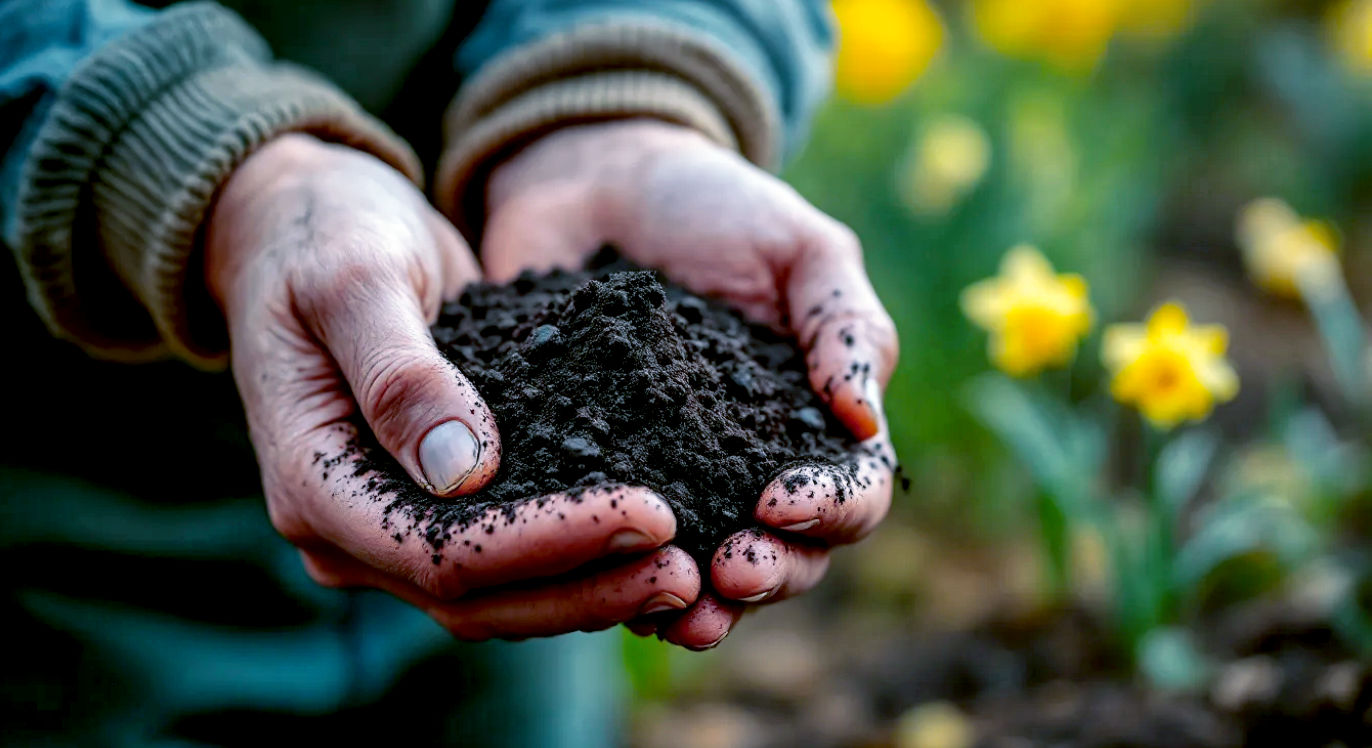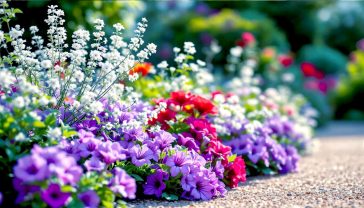The Great British Soil Guide: How to Nurture Your Garden Soil Through the Four Seasons
Your complete guide to year-round soil care in the UK. Learn the secrets to nurturing your soil through the seasons for a healthier, happier garden.

This post may contain affiliate links. If you make a purchase through these links, we may earn a commission at no additional cost to you.
If you ask any seasoned gardener for their number one secret to a brilliant garden, they probably won’t point to a fancy new plant or a clever pruning technique. They’ll look down. They’ll point to the ground and say, “It’s all about the soil.”
For many of us, soil is just… dirt. It’s the mucky stuff that gets on your wellies and under your fingernails. But that humble patch of earth is the single most important part of your garden. It’s not just dirt; it’s a living, breathing ecosystem, a bustling underground city teeming with billions of tiny organisms. Think of it as the stomach of your garden, digesting nutrients and feeding your plants everything they need to thrive.
In Britain, our gardens are shaped by four very distinct seasons. We get the gentle awakening of spring, the glorious (and sometimes scorching) days of summer, the mellow retreat of autumn, and the deep slumber of winter. Your soil goes through this cycle, too. And learning to work with these seasons, rather than against them, is the key to unlocking your garden’s true potential.
This isn’t about complicated science or expensive products. It’s about understanding the rhythm of the year and giving your soil what it needs, when it needs it. It’s a year-long partnership. Get it right, and you’ll be rewarded with healthier plants, bigger harvests, more wildlife, and a garden that truly flourishes. So, let’s dig in and explore the four seasons of soil.
Spring: The Great Awakening
As the first daffodils bravely poke their heads up, you can feel a change in the air. Spring is a time of incredible energy, and beneath your feet, the soil is slowly waking from its winter sleep. It’s often cold, soggy from winter rains, and a bit squashed down. Our job in spring is to gently coax it back to life, warming it up and giving it a good breakfast to prepare for the busy growing season ahead.
First Things First: Keep Off the Grass (and the Soil!)
The number one rule of spring soil care is simple: don’t walk on wet, sticky soil. After a long, wet winter, the ground is often waterlogged. Walking on it squeezes all the tiny air pockets out. This is called compaction, and it’s a disaster for plant roots. They need those air pockets to breathe. If the soil sticks to your boots in great clumps, it’s telling you to wait. Be patient. A few sunny, breezy days can make all the difference. This is especially true for heavy clay soils, which are common across much of the UK.
Warming Things Up
Plants won’t start growing properly until the soil warms up. You can give it a helping hand. Covering a patch of soil with a sheet of black plastic, a cloche, or a cold frame for a few weeks will trap the sun’s warmth. This little trick can give you a head start on sowing early crops like lettuces and radishes, especially in cooler parts of the country, from the Midlands up to the Scottish Highlands.
Weeding: A Stitch in Time
As the soil warms, the first things to leap into action are often the weeds. You’ll see familiar faces like chickweed, bittercress, and dandelions popping up everywhere. Deal with them now, while they’re small and their roots are weak. A quick skim with a hoe on a dry day is often all it takes. Every weed you remove now is one less that will be stealing water and nutrients from your precious plants later on.
The Spring Feast: Feeding Your Soil
After a year of growing, your soil’s pantry is a bit bare. Spring is the time to restock it. The best food you can possibly give your soil is organic matter. This is just a catch-all term for decomposed plant and animal stuff.
- Compost: This is the absolute king of soil food. Good garden compost is dark, crumbly, and smells sweet and earthy. It’s packed with a balanced range of nutrients, but more importantly, it works magic on the soil’s structure. It helps heavy clay soil drain better and helps sandy soil hold on to water. It’s perfect. Spread a generous layer, about 5cm (2 inches) thick, over the surface of your beds.
- Well-Rotted Manure: Another fantastic option. But make sure it’s “well-rotted”—fresh manure is too strong and can scorch plant roots. Rotted manure has been sitting in a pile for at least six months to a year, and it looks a lot like dark compost.
- Green Manures: This is a slightly more advanced trick but well worth knowing. It involves growing a specific crop, like winter tares or field beans, over the winter. In spring, before they start to flower, you simply chop them down and leave the cuttings on the soil surface to rot down for a few weeks before planting. They act as a living blanket, protecting the soil all winter, and then provide a nutrient boost in spring.
To Dig or Not to Dig?
This is one of the great debates in gardening. For generations, British gardeners have religiously dug their plots over each year. The idea is that it breaks up compacted soil, helps with drainage, and buries weeds.
However, a growing number of gardeners are now champions of the “no-dig” method. The argument here is that digging destroys the delicate soil structure and harms the vast network of worms, fungi, and bacteria—the soil food web—that keeps your soil healthy.
With no-dig, you simply layer your organic matter (like compost) on top of the soil once or twice a year and let the worms do the digging for you. They pull the compost down into the soil, creating a fantastic, fertile structure without you ever lifting a spade. It’s easier on your back and, many believe, much better for the soil’s long-term health.
So, what should you do? If you have very heavy, compacted clay, an initial dig to incorporate lots of organic matter can be a good idea. But after that, giving the no-dig method a try might just transform your garden.
Summer: The Season of Support
Summer is when the garden is in full swing. The soil is now a support system, working flat out to pump water and nutrients to your fast-growing plants. Our job is to make sure it doesn’t run out of steam, especially during those hot, dry spells that can quickly turn a lush garden into a crispy, sad-looking place.
Watering Wisely
Watering might seem simple, but doing it right can save water, time, and your plants. The mantra to remember is: water the soil, not the plants.
- Aim for the base: Watering the leaves, especially in bright sun, is a waste. The water just evaporates. Worse, wet leaves can encourage fungal diseases like mildew. Direct your watering can or hose to the soil around the base of the plant.
- Go deep, not shallow: A quick sprinkle every day encourages roots to stay near the surface, where they’ll dry out quickly. It’s much better to give your plants a really deep soak once or twice a week. This encourages the roots to grow deeper into the soil, where they can find moisture even when the surface is dry.
- Timing is everything: The best time to water is early in the morning before the sun gets strong. This gives the water time to soak in properly before it evaporates. Evening is the next best option.
- Embrace the water butt: With climate change bringing hotter, drier summers and more frequent hosepipe bans, collecting rainwater is no longer just a nice idea—it’s essential. A water butt connected to a downpipe from your roof can harvest hundreds of litres of free, soft water that your plants will love.
The Magic of Mulch
If you only do one thing for your soil in summer, do this: mulch it. Mulching is simply covering the surface of the soil with a layer of material. Think of it as a protective blanket for your soil.
Spreading a 5-8cm (2-3 inch) layer of organic mulch, like compost, leafmould, bark chips, or even grass clippings (in thin layers), has amazing benefits:
- It locks in moisture: The mulch acts as a barrier, dramatically slowing down how quickly water evaporates from the soil surface. This means you’ll need to water far less often.
- It smothers weeds: A thick layer of mulch blocks sunlight, preventing many weed seeds from ever getting started.
- It keeps soil cool: On a blazing hot day, bare soil can bake, stressing plant roots. Mulch acts as insulation, keeping the soil at a more even, cooler temperature.
- It feeds the soil: As organic mulches slowly break down, they release nutrients into the soil, feeding the worms and microbes and improving its structure over time.
Apply your mulch in late spring or early summer when the soil is already moist and warm. It’s probably the single most effective thing you can do to help your garden through the summer months.
Topping Up the Tank
Growing takes a lot of energy. Plants like tomatoes, courgettes, and beans are “heavy feeders,” meaning they use up nutrients from the soil very quickly. By mid-summer, they can benefit from an extra boost.
A liquid feed is like an energy drink for your plants. You can make your own by steeping comfrey leaves or nettles in a bucket of water (it’s famously stinky but incredibly effective!), or you can buy a commercial liquid feed, like a seaweed extract or a tomato feed. Apply it every couple of weeks, diluted in your watering can, to keep your plants productive and healthy.
Autumn: The Season of Renewal
As the days shorten and a chill returns to the air, the garden begins to wind down. For the gardener, though, autumn isn’t an ending. It’s the most important season of all for building healthy soil. Think of it as payback time. All summer, your plants have been taking from the soil. Autumn is your chance to give back, replenishing its reserves and tucking it in for the winter.
The Golden Rule: Never Leave Soil Bare
Bare soil is vulnerable soil. Over winter, heavy British rains can wash the precious topsoil away, a process called erosion. It can also batter the soil surface, destroying its structure and leading to compaction. The most important job in autumn is to ensure every inch of your soil is covered.
Put Your Garden to Bed with a Compost Blanket
The best way to cover your soil is with a thick blanket of organic matter. This is the big feed that will set your garden up for the next year. After you’ve cleared away spent summer crops, spread a thick layer—as much as 10cm (4 inches)—of compost, well-rotted manure, or shredded leaves over the entire surface of your beds.
Don’t worry about digging it in. Just lay it on top. Over the winter, the frost, rain, and an army of earthworms will work it all down into the soil for you. When spring arrives, you’ll be greeted with a bed of beautifully structured, nutrient-rich soil, ready for planting.
Leafmould: The Gardener’s Gold
Autumn provides us with a fantastic, free source of soil improver: fallen leaves. Instead of stuffing them in the green bin, rake them up and create a pile in a quiet corner of the garden. You can build a simple cage with chicken wire and posts to stop them blowing away.
Left for a year, the leaves will break down into a lovely, crumbly material called leafmould. Left for two years, they’ll become a fine, dark, compost-like substance. Leafmould is a superb soil conditioner. It doesn’t have many nutrients, but it’s incredible at holding moisture and improving soil structure. Mix it into potting compost or spread it on your beds as a mulch.
Autumn Sowing: Green Manures
Just as you can in spring, you can also sow a green manure crop in autumn. Varieties like grazing rye are perfect. They will grow quickly, creating a dense carpet of green that protects the soil from winter weather. The roots help to hold the soil together, preventing erosion, and the foliage provides a habitat for beneficial insects. In spring, you simply cut it down and let it rot on the surface before you plant your main crops.
Winter: Rest and Protection
Winter is the season of dormancy. The garden appears to be asleep, but under that blanket of mulch, life goes on. Microbes and worms are still busy, slowly breaking down the organic matter you added in autumn, turning it into precious humus—the dark, stable, organic component of soil that is the key to fertility. Our job in winter is mostly to leave it alone and let nature do its work.
Keep Off the Soil (Again!)
This rule is just as important in winter as it is in spring. Walking on frozen soil can damage its structure, and walking on waterlogged soil causes compaction. Use planks of wood to spread your weight if you absolutely must walk on your beds to harvest winter veg like leeks or parsnips.
Plan for the Future
Winter is the perfect time to sit in the warm with a cup of tea and a seed catalogue, planning for the year ahead. A great thing to plan is crop rotation.
This means not growing the same type of vegetable in the same patch of soil year after year. For example, the cabbage family is prone to a disease called clubroot, which can build up in the soil. If you move them to a different spot each year, the disease doesn’t get a chance to take hold. Different plants also take different nutrients from the soil. Rotating them helps to keep the soil balanced. A simple three or four-year rotation plan can make a huge difference to the health of your veg patch.
A Final Check
Occasionally, pop out on a dry day to check on things. Make sure your winter mulches haven’t been blown away by strong winds. Check your compost bin—if it’s not frozen solid, giving it a turn can help speed up decomposition. But mostly, winter is a time for the soil to rest and recharge.
Going Deeper: Getting to Know Your Soil
Understanding the seasonal cycle is key, but it also helps to know a little bit about the type of soil you actually have. All soil is made of three main mineral particles: sand, silt, and clay. The mix of these particles determines your soil’s texture.
You can do a simple test. Take a small, moist handful of soil and try to roll it into a ball, then a sausage shape.
- If it feels gritty and falls apart, you have sandy soil. It drains quickly and warms up fast in spring, but it doesn’t hold on to water or nutrients well.
- If it feels silky or soapy and holds its shape, you have silty soil. This is generally quite fertile and holds water well.
- If it feels sticky and you can easily bend it into a ring without it breaking, you have clay soil. This is common in the UK. It’s packed with nutrients but can be heavy, slow to drain, and slow to warm up.
The dream for gardeners is loam, which is a balanced mix of all three. But don’t worry if you don’t have it. The answer to improving any soil type is always the same: add more organic matter. Compost, manure, and leafmould will bind sandy soil together to hold water, and they will open up clay soil to improve drainage. It’s a win-win.
Beyond texture, think about the life in your soil. That dark, crumbly earth is home to more living creatures in a single teaspoon than there are people on the planet. This soil food web includes everything from microscopic bacteria and fungi to beetles, centipedes, and, of course, the gardener’s best friend, the earthworm. These creatures are your workforce. They break down organic matter, recycle nutrients, and create the perfect soil structure. Looking after them by avoiding chemical pesticides and minimising digging is one of the best things you can do for your garden.
Your Soil, Your Garden
Nurturing your soil isn’t a single task to be ticked off a list; it’s a gentle, continuous conversation that you have with your garden throughout the year. It’s about observing, understanding, and responding to its needs as the seasons turn.
By feeding it in the spring, protecting it in the summer, replenishing it in the autumn, and letting it rest in the winter, you are doing more than just growing plants. You are building a resilient, living foundation. You are creating a virtuous cycle where the soil feeds the plants, the plants (as compost) feed the soil, and the whole system becomes richer, healthier, and more alive with every passing year. This is the simple, powerful secret to a truly great British garden.
Further Reading
For those who wish to dig even deeper, these resources are highly recommended:
- The Royal Horticultural Society (RHS): Soil Types, pH and Fertilisers
- Garden Organic: Soil and Composting Advice
- The Soil Association: Save Our Soil
- Charles Dowding’s No-Dig Gardening: No-Dig Information and Resources






